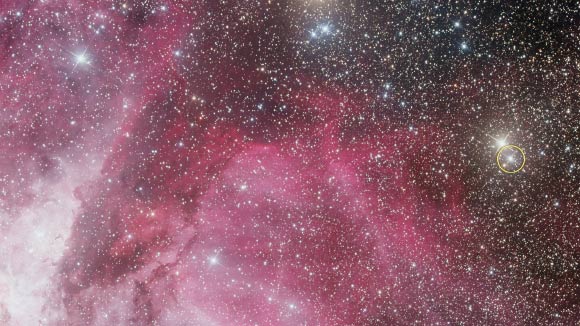Astronomers Track Shock Waves in Nova V906 Carinae | Astronomy – Sci-News.com
A nova is a sudden, short-lived brightening of an otherwise inconspicuous star. It occurs when a stream of hydrogen from a companion star flows onto the surface of a white dwarf. New observations of V906 Carinae, a nova that is about 13,000 light-years away in the constellation of Carina, by NASA’s Fermi Gamma-ray Space Telescope and Nuclear Spectroscopic Telescope Array (NuSTAR), the Canadian BRITE-Toronto satellite and several ground-based facilities have captured the first direct evidence that most of the nova’s visible light arose from shock waves.

V906 Carinae (circled) shines near peak brightness in this image taken on March 23, 2018, three days after the nova was discovered. The beautiful cloud of gas and dust dominating the picture is part of the Carina Nebula. Image credit: A. Maury / J. Fabrega.
“This is a new way of understanding the origin of the brightness of novae and other stellar explosions,” said Dr. Elias Aydi, a researcher in the Department of Physics and Astronomy at Michigan State University.
“Our findings present the first direct observational evidence, from unprecedented space observations, that shocks play a major role in powering these events.”
“So, what are shocks and how do they form? Picture a supersonic jet airplane. When the jet exceeds the speed of sound, it produces a shock which leads to a loud sonic boom. In a nova explosion, the shocks produce light rather than sound.”
“When material blasts out from the white dwarf, it is ejected in multiple phases and at different speeds. These ejections collide with one another and create shocks, which heat the ejected material producing much of the light.”
“Another side effect of astronomical shocks are gamma-rays, the highest-energy kind of electromagnetic radiation.”
The team detected bright gamma-rays from V906 Carinae (also known as ASASSN-18fv), whose explosion was first detected in March 2018.
Using the Fermi telescope, the astronomers showed that the event had the brightest gamma-rays ever observed for a nova, proving that it hosts energetic shocks.
But the real surprise came because the BRITE-Toronto satellite just happened to be looking at the part of the sky where the nova occurred.
Comparing the gamma-ray and optical data, the researchers noted that every time there was a fluctuation in gamma-rays, the light from the nova fluctuated as well.
“When we compare the Fermi and BRITE data, we see flares in both at about the same time, so they must share the same source — shock waves in the fast-moving debris,” said Dr. Koji Mukai, an astrophysicist at the University of Maryland Baltimore County and NASA’s Goddard Space Flight Center.
“When we look more closely, there is an indication that the flares in gamma rays may lead the flares in the visible. The natural interpretation is that the gamma-ray flares drove the optical changes.”
“We observed simultaneous fluctuations in both the visual and gamma-ray brightness, meaning that both emissions are originating from shocks,” said co-author Dr. Kirill Sokolovsky, a scientist in the Department of Physics and Astronomy at Michigan State University.
“This led us to the conclusion that shocks are indeed responsible for most of the brightness of the event.”
“We were lucky that members of our team were observing that part of the sky with these special satellites and were able to collect this unprecedented set of data,” Dr. Aydi added.
A paper on the findings was published in the journal Nature Astronomy.
_____
E. Aydi et al. Direct evidence for shock-powered optical emission in a nova. Nat Astron, published online April 13, 2020; doi: 10.1038/s41550-020-1070-y





